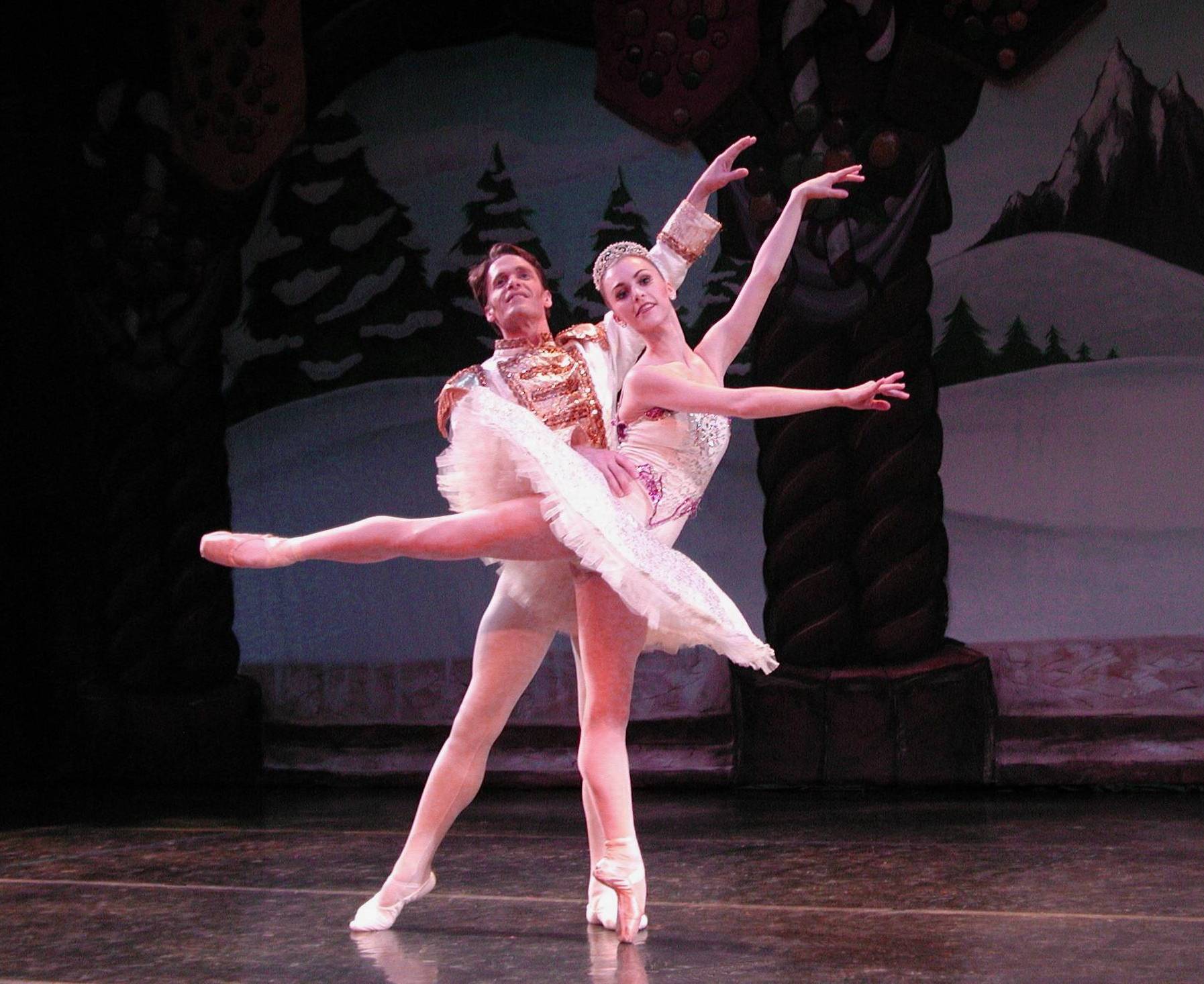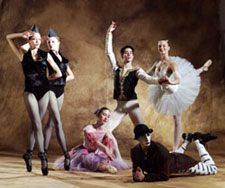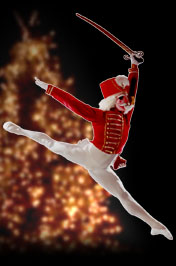For the Brave: Dancing the Nutcracker
Lightsey Darst sees productions of "The Nutcracker"--really sees them. They remind her of her own experiences with this venerable event.




This year I decided to go in search of an old experience by seeing every Nutcracker in town. It turns out that there are quite a few, including touring shows, but I did make it to five, performed by Ballet Arts Minnesota (City Children’s Nutcracker), Minnetonka Dance Theatre, Minnesota Ballet, Minnesota Dance Theater (MDT), and Ethnic Dance Theatre.
I got nothing but sympathy for undertaking this project. “Nutcracker-watching?” asks a friend. “Do you have special drugs for that?” “The Nutcracker,” says another friend. “That’s Tchaikovsky’s worst. Take the Fifth Symphony; that’s real Tchaikovsky.” Callow, I decide, and cross him off my Christmas list.
But I understand why people hate the Nutcracker. Take the party scene that fills the first act of the ballet: it’s a series of silly vignettes linked by incomprehensible mime and supported by maudlin and disjunctive music. Strange tumblers and toys accompany Drosselmeyer, but no one really dances until almost the end of the first act, and by then it may be too late for some of us. What are we supposed to be enjoying? A live recreation of a Victorian party, complete with lame jokes, tame frocks, and low-tech toys? I’ve always wondered why that party scene stays so much intact from one production to another, down to the furry-looking pantaloons the girls wear under their skirts. Watching the party scene is like playing charades with someone else’s grandmother. And then there’s the audience, screaming kids and their even less happy parents, little princesses and their princess mothers, and you, wondering why you are here again, watching the Nutcracker, when you could be outside shopping, or even better, at home drinking eggnog with a tiny bit (maybe more than a tiny bit) of brandy in it.
On the other hand, if you can get through all that, you can be rewarded with something extraordinary.
What was that old experience I had? Two experiences, actually. First, imagine a sixteen-year-old. I had desire but no direction; I was waiting for something but prepared for nothing; I tried to govern myself by what I thought were beliefs, but they were more like superstitions, strange rules that I invented or broke as I felt my way. I didn’t know what I wanted my life to be, and it ached. The guidance counselors had books of occupations, none of which fitted me, though I couldn’t say why. I wasn’t an artist; no one had suggested to me that I should be an artist, and I hadn’t realized it was possible. Even though I’d been dancing for most of my life, I didn’t want to be a dancer; I hadn’t wanted that since I was little. I thought dance and art were too far away, only for the rarely talented, not for me.
I went to see the Nutcracker with my parents. We went to the Monticello opera house, a old brick building on the roundabout at the center of Monticello, a little town about thirty foggy and crepe myrtle-lined miles from my Tallahassee home. Inside the theater was tiny and lovely, like a paper model, with boxes on either side of the stage. It was the kind of building that burns down in a bad dream of home.
We went to see the company attached to my ballet school. I had just switched schools, from a vinyl-floored “studio” in a strip mall to the Southern Academy of Ballet Arts, an “academy” in an old warehouse near downtown. Where I had been one of the older and more accomplished dancers at my school, I was suddenly far behind the other girls my age, these dancers with high extensions, multiple turns, and rapid footwork. I loved the new school, wanted to be there and to learn, but it was hard. That October, I twisted my knee the wrong direction and tore cartilage; by the time of the Nutcracker I hadn’t danced in a month, and I had an appointment for surgery.
The Nutcracker began at the snow scene. Blue light, white tulle, as much dance as a tiny stage could hold. My mother, always the sentimental one, began to cry. The clapping of Spanish, partnered contortions of Arabian, sharp-footed Chinese, the Russian dance in which Carl Wooland leapt through applause into sixteen straight straddle jumps, flirty Marzipan, lovely Flowers, and then, at the end, the stage echoing with the color and motion, the grande pas de deux, the Sugarplum and her Cavalier. Alison McGlamry, pretty and vivacious, the unspoken queen of the school, danced it, supported by Adam Perry, the strongest man at the school.
If you’ve never heard the music or can’t remember it, stop now and google it. It’s absurd, heart-wrenching music; every time you think Tchaikovsky has put in all he can, he adds another note. The dread that comes back again and again in the ballet finds its apotheosis here; there’s a sugary, swaying line that keeps descending and rising only to descend, so sweet you want to hurt yourself, and so sad you feel thoroughly alive, with all the heartbreak living brings. As Tchaikovsky tells you, over and over, that it’s doomed, art, love, life, it can’t last, the beautiful beings on stage enact, over and over again, the embraces of supreme love, of youth, of the communion that passes understanding.
I cried. I was surprised. It was a new kind of crying, not tied to a moment or an incident, but to an overwhelming feeling about the truths of the world. I cried because I loved more than anything the dream promised by the dancing, and felt that it was closed to me—because of my injury, my lack of talent, my lack of strength, my place in the world, everything.
I decided to ask some authorities what they think of the Nutcracker. I interviewed Brittany Fridenstine and Matthew Keefe, who played the Sugarplum Fairy and Cavalier/Nutcracker in three performances around town, including the Minnetonka production. (Keefe and Fridenstine are also members of the James Sewell Ballet.)
Do they dislike the Nutcracker, consider it a grind and a holiday chore? No: “Most ballet dancers groan when they hear the music,” admits Keefe, “but I believe in the story. It is magical.” Fridenstine still finds the Nutcracker moving, even after growing up with it. As guest artists, Keefe and Fridenstine consider themselves ambassadors, spreading a holiday mood and setting a professional example for the other dancers, who are also their students. How does performing the Nutcracker relate to their careers in a modern ballet company? Fridenstine replies, “Classical dancing is my base. . . the better connected to it I become the more I feel I can take risks and stretch myself into the more contemporary realm.”
Keefe and Fridenstine feel lucky to dance yet another Nutcracker: “Sugarplum is still a fantasy role to me,” Fridenstine says.
So which Nutcracker should you see? If you’re planning to go, you probably already know which Nutcracker you’re seeing; maybe your niece plays the second mouse from the left. Or maybe you always go to the same Nutcracker, every year, for no particular reason. Maybe you don’t go at all; you’re either mourning the lack of Ballet of the Dolls’ naughty Nutcracker, or you don’t want to go, don’t think of the Nutcracker as art. However, I think you should go. Why not? I did.
For sheer beauty, I would pick MDT’s Nutcracker (at the State Theater, this weekend). MDT wisely crowds the stage with props for the party scene and makes the party heavy on dancing, where it’s usually half mime and corny jokes, and the costumes are beautiful. MDT also has the best choreography in the snow scene, and a completely live, very skilled orchestra. The Nutcracker with live music is an entirely different animal: suddenly you understand that in the Waltz of the Flowers, Rose is the harp, embodied. Tchaikovsky’s orchestration includes (and relies on) the dance. Strangely, though, MDT’s second act feels spare in comparison to the first, unmagical, a bit austere. Still, this production was my favorite.
For a Nutcracker that feels like Minneapolis, go to the City Children’s (already over for this year, but definitely returning for next). Children from the city’s various parks programs show up throughout the show, and the ballet is combined with roller-skating, stilt-walking, and other performances. The Nutcracker prince demonstrates a machine dance and then break-dances. City Children’s goes the farthest to change the Nutcracker and make it interesting. Nutcracker performances usually strive to be beautiful, rather than interesting, but why not see what else this story and music can hold?
If you’re entirely sick of the usual, try Ethnic Dance Theatre’s Nutcracker (at Concordia University, this weekend). Staging the Nutcracker with authentic folk dances instead of ballet sounds like an innovation, but it feels familiar; I was reminded of the “Christmas Traditions of the World” film-strips that used to show up in seventh grade classes this time of year. I mean that in the best possible way: EDT’s Nutcracker, with its various puzzling but enjoyable traditions, feels more like the holidays than any other production. EDT’s fight scene (between Georgian rats and Ukrainian heroes) is the most exciting I saw, with real sparks flying from the swords. Also, after hearing EDT’s orchestra, I’m convinced that every production of the Nutcracker should have a concertina.
Minnetonka’s production (already over for this year) has a home-town feel, down to the overload of credits in the program. Families and friends filled the audience and applauded enthusiastically, while kids tumbled in the aisles. Small amateur companies all over the U.S. produce the Nutcracker every year. Mothers make the costumes, the dancers rehearse for hours, someone’s father works on the set—and then, for one weekend, they have their Nutcracker. Minnetonka did well.
Ballet Minnesota dances in the intimate O’Shaughnessy (this weekend), accompanied by the Mississippi Valley Orchestra. As in Minnetonka’s production, imported professionals fill in for Sugarplum and her Cavalier, the choreography is not terribly interesting, and the dancers are mostly students. Costumes (Cheryl Rist) and sets (Jim Arnold, Lisa Gray, and Cynthia Betz), though, look professional.
What about the politics of the Nutcracker? Let’s see: a little girl is charmed by the gift of a Nutcracker, who morphs into a handsome young man; together they murder a mouse; then they travel to a fantasy land in which they’re entertained by sassy Spaniards, mysterious and sexy Arabians, cheeky and wicked Chinese, robust Russian peasants, and Mother Ginger—a drag queen who breeds like a rabbit. And then there’s ballet itself: men support, women float, men wear tights, women wear tutus, the sexes are inalterably divided and their roles are strictly defined. Why do some mothers grumble about taking their daughters to the Nutcracker? Because they don’t want them to grow up to be anyone’s sugarplum.
I can’t speak for the Arabian. We could call the dance by its other name, Coffee (everything in this ballet has two names), or argue that it’s merely conventional, that no one really thinks of the Arabian dance as Middle-Eastern. But the first approach doesn’t solve the problem, and the second is a lie. Those companies do best which offer equal-opportunity exoticism: take MDT’s version, in which a bare-bellied woman and a bare-chested man alternately slither into your attention. Or you can solve the problem of the “ethnic” dances by making them in fact ethnic dances: Ethnic Dance Theater uses not ballet, but the indigenous dances of various countries, so that Arabian becomes Egyptian, a dance of dignified hip-shaking and tricks with canes.
Classical ballet repeats old-fashioned gender roles because it repeats old-fashioned ballets. Why doesn’t someone update it? Because the roles play to the usual strengths of the sexes. Most men can lift most women better than most women can lift most men. This isn’t an entirely satisfactory answer, I know; it leaves all kinds of gaps. But I can speak for the sexual politics of this ballet. Clara is the one who kills the mouse king; the Sugarplum Fairy, not the Cavalier, is the ruler of the Land of Sweets. Drosselmeyer is a clever trickster, but the real magic is Clara’s love and imagination.
Some scenes from the Nutcrackers I saw stick in my head:
In MDT’s Nutcracker, a woman spins in the center of a whirl of dancers, smiling every time she snaps her head. Above her hang chandeliers and beneath, beside, around her is the swelling Waltz of the Flowers. City Children’s Nutcracker: Drosselmeyer is tethered to a crowd of lozenge-shaped balloons. Instead of being lifted by the balloons, he bends, as if weighed down. Stilt-walkers with long scissors come from the wings and circle Drosselmeyer, snipping at the balloon-strings, freeing him. EDT: women in long robes trimmed with fur carry globes of light and weave slow patterns on the stage while women sing in Russian.
One of the pleasures of local Nutcrackers is future star spotting. I would be remiss if I didn’t mention a certain tiny brunette in the City Children’s Nutcracker, or a lovely and precise dancer in the Minnetonka Dance Theater’s Waltz of the Flowers. It’s also fun to catch prominent local dancers in their holiday roles—Stephanie Fellner demure and innocent for City Children’s Marie, Uri Sands flaunting a red cape as MDT’s Drosselmeyer, the ultimate showman.
Good performances abound. I liked Erin Warn, Ballet Minnesota’s Rose, for her charm and musicality. Mifa Ko (MDT) makes a lovely Snow Queen. The best performances have weight as well as lightness: MDT’s Rose (name not available at press time) spins like a clockwork, but she also fills space, radiates pleasure and welcome, and grows through her balances. Hughes Magen (City Children’s) gives a dark Drosselmeyer, sinister even as he hands out presents to the children. Brittany Fridenstine’s Sugarplum Fairy is not merely a confection: you have the impression she’s considering the day-to-day business of the Kingdom of Sweets as she dances. Fridenstine doesn’t flaunt her balances or “nail” her fouettes; she makes them part of the dance, part of the character she invents.
Back to the other half of my experience. The second time I saw the Nutcracker, I was twenty, and everything had changed.
I had joined the company and danced in the Nutcracker myself by then. I had driven myself to and from that tiny opera house during theater week, gotten snow in my eyelashes. I was a better dancer, and between sixteen and twenty I learned what it meant to dance as an artist, not only as an athlete. I learned it all at once, during rehearsals for Les Sylphides, which used to go on for hour after unreal hour under the direction of my teacher’s elderly mother, Miss Ashton. Dancing as an artist meant not knowing everything, giving up control to the music and to Miss Ashton, and then finding myself again, but some different and unseen self, in the steps, in the music. It was my first experience with the large unknowing that is art.
Miss Ashton died in the summer. That fall semester, I studied in London. I spent hours wandering around the city, looking and thinking. Ideas, images crept into the spaces of my mind; I felt suddenly porous, not scared or defensive, as I had been in high school. I could change and I did. I realized I didn’t want what most people around me did. I needed a different life; I didn’t know what that would be, but I knew I would leave Tallahassee in search of it. I kept dancing while in London (the knee injury was mostly healed); I went to Pineapple Studios and saw all kinds of bodies and talents, all trying hard and mostly failing. I had always thought dance was too hard for me; I saw it was hard for everyone.
I came back home for Christmas. Tallahassee looked small. At the theater everyone was busy and excited and just had time to admire my new short hair. I knew what I would see, I knew the dancers and the choreography, and I had seen so much else now; I thought I wouldn’t be affected. But then the grande pas de deux began. This time, I didn’t feel shut out of the vision. The vision (of beauty, of perfect communication, of true life) recedes before everyone, no matter how lucky or talented. Miss Ashton had danced around the world when she was young and she still knew what I meant when I told her I couldn’t do justice to the dance. It’s the promise itself that is the perfect communication, and rising to receive it (audience) or stepping forward to offer it (dancers, musicians) we are both blessed.
Art is not only for the rarely talented. Art is for the brave above all. The Nutcracker taught me this, and I will always be grateful.